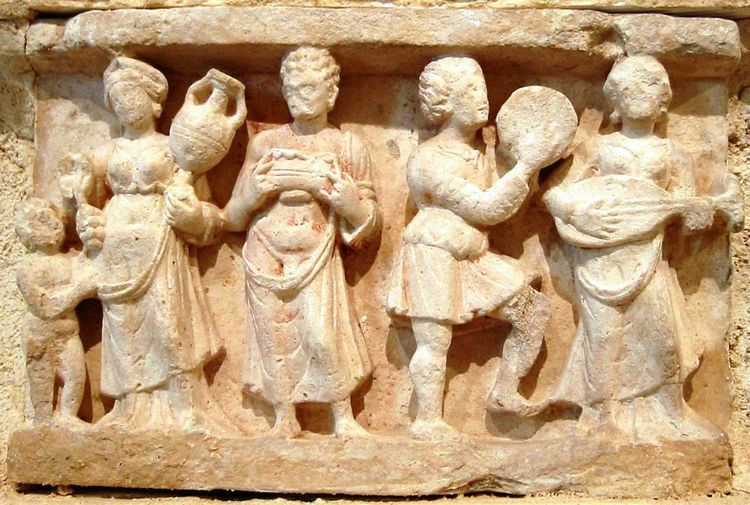 | ||
The art of the Indo-Greek is poorly documented, and few works of art (apart from their coins and a few stone palettes) are directly attributed to them. The coinage of the Indo-Greeks however is generally considered as some of the most artistically brilliant of Antiquity. The Hellenistic heritage (Ai-Khanoum) and artistic proficiency of the Indo-Greek would suggest a rich sculptural tradition as well, but traditionally very few sculptural remains have been attributed to them. On the contrary, most Gandharan Hellenistic works of art are usually attributed to the direct successors of the Indo-Greeks in India in the 1st century CE, such as the nomadic Indo-Scythians, the Indo-Parthians and, in an already decadent state, the Kushans In general, Gandharan sculpture cannot be dated exactly, leaving the exact chronology open to interpretation.
Contents
Incipient Greco-Buddhist art
The possibility of a direct connection between the Indo-Greeks and Greco-Buddhist art has been reaffirmed recently as the dating of the rule of Indo-Greek kings has been extended to the first decades of the 1st century CE, with the reign of Strato II in the Punjab. Also, Foucher, Tarn and more recently Boardman, Bussagli or McEvilley have taken the view that some of the most purely Hellenistic works of northwestern India and Afghanistan, may actually be wrongly attributed to later centuries, and instead belong to a period one or two centuries earlier, to the time of the Indo-Greeks in the 2nd-1st century BCE:
This is particularly the case of some purely Hellenistic works in Hadda, Afghanistan, an area which "might indeed be the cradle of incipient Buddhist sculpture in Indo-Greek style". Referring to one of the Buddha triads in Hadda (drawing), in which the Buddha is sided by very Classical depictions of Herakles/Vajrapani and Tyche/Hariti, Boardman explains that both figures "might at first (and even second) glance, pass as, say, from Asia Minor or Syria of the first or second century BC (...) these are essentially Greek figures, executed by artists fully conversant with far more than the externals of the Classical style". Many of the works of art at Hadda can also be compared to the style of the 2nd century BCE sculptures of the Hellenistic world, such as those of the Temple of Olympia at Bassae in Greece, which could also suggest roughly contemporary dates.
Alternatively, it has been suggested that these works of art may have been executed by itinerant Greek artists during the time of maritime contacts with the West from the 1st to the 3rd century CE.
The supposition that such highly Hellenistic and, at the same time Buddhist, works of art belong to the Indo-Greek period would be consistent with the known Buddhist activity of the Indo-Greeks (the Milinda Panha etc...), their Hellenistic cultural heritage which would naturally have induced them to produce extensive statuary, their know artistic proficiency as seen on their coins until around 50 BCE, and the dated appearance of already complex iconography incorporating Hellenistic sculptural codes with the Bimaran casket in the early 1st century CE.
Indo-Greeks in the art of Gandhara
The Greco-Buddhist art of Gandhara, beyond the omnipresence of Greek style and stylistic elements which might be simply considered as an enduring artistic tradition, offers numerous depictions of people in Greek Classical realistic style, attitudes and fashion (clothes such as the chiton and the himation, similar in form and style to the 2nd century BCE Greco-Bactrian statues of Ai-Khanoum, hairstyle), holding contraptions which are characteristic of Greek culture (amphoras, "kantaros" Greek drinking cups), in situations which can range from festive (such as Bacchanalian scenes) to Buddhist-devotional.
Uncertainties in dating make it unclear whether these works of art actually depict Greeks of the period of Indo-Greek rule up to the 1st century BCE, or remaining Greek communities under the rule of the Indo-Parthians or Kushans in the 1st and 2nd century CE.
Stone palettes
Numerous early stone palettes found in Gandhara are considered as direct productions of the Indo-Greeks during the 2nd to the 1st century BCE. The art style of the palettes later evolved under the Indo-Scythians and Indo-Parthians, but production stopped with the advent of the Kushans. Usually these palettes represent people in Greek dress in mythological or gallant scenes.
Hellenistic groups
A series of reliefs, several of them known as the Buner reliefs which were taken during the 19th century from Buddhist structures near the area of Buner in northern Pakistan, depict in perfect Hellenistic style gatherings of people in Greek dress, socializing, drinking or playing music. Some other of these reliefs depict Indo-Scythian soldiers in uniform, sometimes playing instruments. Finally, revelling Indian in dhotis richly adorned with jewelry are also shown. These are considered some of the most artistically perfect, and earliest, of Gandharan sculptures, and are thought to exalt multicultural interaction within the context of Buddhism, in the 1st century BCE or the 1st century CE.
Bacchic scenes
Greeks harvesting grapes, Greeks drinking and revelling, scenes of erotical courtship are also numerous, and seem to relate to some of the most remarkable traits of Greek culture. These reliefs also belong to Buddhist structures, and it is sometimes suggested that they might represent some kind of paradisical world after death.
Hellenistic devotees
Depictions of people in Hellenistic dress within a Buddhist context are also numerous. Some show a Greek devotee couple circambulating stupas together with shaven monks, others Greek protagonists are incorporated in Buddhist jataka stories of the life of the Buddha (relief of The Great Departure), others are simply depicted as devotees on the columns of Buddhist structures. A few famous friezes, including one in the British Museum, also depict the story of the Trojan horse. It is unclear whether these reliefs actually depict contemporary Greek devotees in the area of Gandhara, or if they are just part of a remaining artistic tradition. Most of these reliefs are usually dated to the 1st-3rd century CE.
